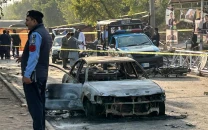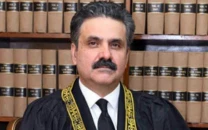The week after
Those who got PTI over the finish line are residents of K-P, a different segment from elites of Lahore and Karachi.

The writer is an Assistant Professor of Public Policy at the University of Maryland, and a Non-Resident Fellow at the Brookings Institution. She tweets @MadihaAfzal
While a small number of results may turn out to be affected by vote rigging and irregularities, these election results truly reflect the voice of the Pakistani people. My research using election results and development funds data from the 1990s shows that Pakistani voters are not irrational: they will vote for the candidate or party, who provides them the most benefits, and against those they see as having wronged them. For its resounding victory, the PML-N deserves nothing but congratulations, genuine goodwill and support for tackling the monumental tasks it faces. Nawaz Sharif has shown maturity in his last five years in the opposition and exudes determination going forward. These characteristics will serve him well in office.
Imran Khan deserves accolades for energising Pakistan’s vocal urban youth, as well as many older, educated, and previously politically unengaged urbanites in turning out to vote. As such, the increase in voter turnout to around 60 per cent must, at least, partly be attributed to his efforts. The PTI is now a formidable third party in Pakistan, fundamentally changing the structure of the Pakistani party system and democracy as we know it. According to my calculations based on data from the Election Commission of Pakistan’s (ECP) website (as of May 16), of Punjab’s 138 National Assembly constituencies where the PTI was not the winner (it won eight National Assembly seats in Punjab) and where results were not withheld, the second runner-up candidate belonged to the PTI in 48 constituencies. That is an impressive achievement, one which the PTI and Mr Khan must be very proud of. It demonstrates that the PTI has made considerable inroads in Punjab.
The passion of Mr Khan’s followers in documenting and protesting vote-rigging, ballot stuffing and other illegal activities at polling stations over the last week also deserves commendation and heralds the arrival of a Naya Pakistan, one in which citizens speak up when they are wronged, a Pakistan which demands fairness and justice. Mr Khan’s appeal to the ECP to look into vote-rigging in 25 constituencies should be taken very seriously, whether it changes the results of the election in his favour or not. Regardless of whether ballot-stuffing happened in four constituencies or 40, it is illegal, and a truly fair electoral system should tolerate no instance of it.
But let’s talk for a minute about where the PTI did very well — Khyber-Pakhtunkhwa. Mr Khan’s party won 17 out of its 27 National Assembly seats there, and a plurality in the K-P provincial assembly, winning 35 seats out of 99. Mr Khan’s supporters on social media have hailed the Pashtuns as visionaries, as being more progressive than the rest of Pakistan. Photographs of a modern Peshawar skyline in 2018 as the outcome of five years of a provincial PTI government are doing the rounds. But are the Pashtuns really the idealists they are being made out to be, the path-breakers to a Naya Pakistan? What about the role of the Taliban in all this?
The truth is a lot less romantic than the PTI stalwarts would proclaim. We know that the PTI is the only party that was able to effectively campaign in K-P given the Taliban’s brutal and unrelenting assault on the ANP. True, the ANP faced a disadvantage as the incumbent provincial government, which supervised over a terrible five years in K-P. Nevertheless, it is astounding that it got no sympathy for the bullets and the bombs it took for Pakistani democracy. Not from the voters of K-P, and not from the active PTI protesters who were out at Teen Talwar and Lalik Chowk protesting alleged election fraud in Karachi and Lahore. What do these newly mobilised youth think of the fact that the Taliban essentially handed the K-P to the PTI?
Regionalism and provincialism, already reflected in the election results, have become even more pronounced in this past week as blame is assigned for not embracing Mr Khan’s vision, and class fissures have opened up. The Punjabis are being maligned by PTI supporters outside Punjab for being misguided, and rural Punjabis denigrated by urban Punjabis for being irrational. No one is thinking of Balochistan at all, where turnout was dismal amid security concerns. The truth is that the PTI energised and engaged a minority, the urban young, who did not, in the end, garner it significant voting power in parliament.
This is not to discount by any means the notable performance of the PTI candidates as runners-up in Punjab’s constituencies. But the irony is that those who got the PTI over the finish line are the residents of K-P, a very different segment from the elite Lahore and Karachi base, who consider themselves the PTI’s face. In the end, the illusion generated by massive rallies in Lahore and Islamabad belied the truth that the PTI represented but a minority of Pakistan’s population. Mr Khan led an extraordinary campaign, and over the next five years, he can make significant inroads where he does not yet have a base: in rural Punjab and in Sindh and Balochistan.
Published in The Express Tribune, May 21st, 2013.















COMMENTS
Comments are moderated and generally will be posted if they are on-topic and not abusive.
For more information, please see our Comments FAQ